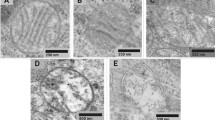Summary
We have tested the hypothesis that chronic exposure to the principal constituents of the aqueous fraction of coal tar extracts can lead to the in vivo formation of substances which may produce neurological damage as the result of free radical generation and lipid peroxidation, these may be involved in the etiology of some neurological disorders. Artificial mixtures of the aqueous fraction of coal tar extracts were given in low concentrations to pigmented mice in their drinking water over a 3-month period. This resulted in significant increases in lipid peroxidation in the striatum, cerebellum and liver of the mice under test, the rank order being striatum > cerebellum > liver. These results are compatible with the possibility that coal tar emissions (as would be recovered or liberated in the burning, refining or beneficiation of coal) constitute a potential source of neurotoxicants with a predilection for damaging the nigrostriatal neuronal pathway. Our observations may thus have identified an important and hitherto unsuspected environmental source of neurotoxic chemicals, a possibility consistent with the proposed involvement of an environmental chemical factor in Parkinson's disease and perhaps in other neurological disorders.
Similar content being viewed by others
References
Perov OV: Changes in antioxidative activity of cells and functions of the nucleus by the action of subtoxic doses of phenolpyridine mixtures from coal tar. Bull Exp Biol Med 73:267–270, 1972
Halliwell B, Gutteridge JMC: Oxygen radicals and the nervous system. Trends in NeuroSci (TINS) 8:22–26, 1985
Cohen G: Oxidative stress in the nervous system. In: Oxidative Stress, H. Siess ed., Academic Press, London, 1985, pp 383–402
Mead JF: Free radical mechanisms in lipid peroxidation and prostaglandins. In: Free radicals in molecular biology, aging and disease, D Armstrong, RS Sohal, RG Cutler and TF Slater eds., Aging Series, Vol 27. Raven Press, New York, 1984, pp 53–66
David GC, Williams AC, Markey SP, Ebert MH, Caine ED, Reichert CM, Kopin IJ: Chronic parkinsonism secondary to intravenous injection of meperidine analogues. Psychiatr Res 1:249–254, 1979
Parisi JE, Burne RS: The neuropathology of MPTP-induced parkinsonism in man and experimental animals. In: MPTP: A neurotoxin producing a parkinsonian syndrome. SP Markey, NM Castognoli, Jr., AJ Trevor and IJ Kopin eds, Academic Press, Orlando, 1986, pp 141–148
Ziering Z, Berger L, Heineman DS, Lee J: Piperidine derivatives. Part III. 4-arylpiperidines. J Org Chem 12:894–903, 1947
Yeng JM, Corleto LA, Knaus EE: Synthesis of N[[(Substituted-phenyl) carbonyl] amino]-1,2,3,6,tetrahydropyridines with analgesic and hyperglycemic activity. J Med Chem 25:720–723, 1982
Dua AK, Bose R, Pinsky C: N-methyl-4-phenyl-1,2,3,6-tetrahydropyridine (NMPTP) treatment in mice may provide animal model for parkinsonism. Ann Conf Chem Inst of Canada 67:ME 6–05, 1984
Belknap JK, Goebel DM, Haltli NR, Lame M: Intercorrelations between levorphanol-induced antinociception, hypothermia, activity and constipation in a genetically heterogenous mouse population, and the results of selective breeding for antinociception. Proc West Pharmacol Soc 25:299–302, 1982
Belknap JK, Halth NR, Goebel DM, Lame M: Selective breeding for high and low levels of opiate-induced analgesia in mice. Behav Genetics 13:383–396, 1983
Costall B, Eniojukan JF, Naylor RJ: Spontaneous climbing behaviour of mice, its measurement and dopaminergic involvement. Eur J Pharmacol 85:125–132, 1982
Protais P, Costetin J, Schwartz JC: Climbing behaviour induced by apomorphine in mice. A simple test for study of dopamine receptors in striatum. Psychopharmacology 50:1–6, 1976
Donaldson J, LaBella FS: The effects of manganese on the cholinergic receptor in vivo and in vitro may be mediated through modulation of free radicals. Neurotoxicology 5:105–112, 1984
Spencer DF, Alpert SB, Gilman HH: Cool Water: Demonstration of a clean and efficient new coal technology. Science 232:609–612, 1986
Noller CR: Chemistry of Organic Compounds. WB Saunders Company, Philadelphia, 1965, p 668
Zigmond MJ, Acheson AL, Stachowiak MK, Strickerm EM: Neurochemical compensation after nigrostriatal bundle injury in an animal model of preclinical parkinsonism. Arch Neurol 41:856–861, 1984
Bernheimer H, Birkmayer W, Hornykiewicz O, Jellinger K, Seitelberger F: Brain dopamine and the syndromes of Parkson and Huntington, clinical, morphological and neurochemical correlations. J Neurol Sci 20:415–455, 1973
Parkinson J: An essay on the shaking palsy. Sherwood, Neely and Jones, London, 1817, pp 1–34
Blake W: The chimney sweeper (two poems). In: The Norton Anthology of English Literature, MH Abrams ed., 5th Edition, Vol. 2, WW Norton and Company, New York, 1986, pp 33 and 39
Blake W: And did those feet. In: The Norton Anthology of English Literature, MH Abrams ed., 5th Edition, Vol. 2. W W Norton and Company, New York, 1986, pp 77–78
Lewin R: Trail of ironies to Parkinson's disease. Science 224:1083–1084, 1984
Lewin R: Parkinson's disease: An environmental cause? Science 229:257–258, 1985
Desclin JC: Histological evidence supporting the inferior olive as the major source of cerebellar climbing fibres in the rat. Brain Res 77:365–384, 1974
Balaban CD: Central neurotoxic effects of intraperitoneally administered 3-acetylpyridine, harmaline and niacinamide in Sprague-Dawley and Long-Evans rats: a critical review of central 3-acetylpyridine neurotoxicity. Brain Res Rev 9:21–42, 1985
Bose R, Pinsky C: 3-and 4-acetylpyridine display differential potency on central dopaminergic function in mice. Proc Can Fed Biol Soc 30:111, 1987
Abramovitch RA (editor): Pyridine and its derivatives. John Wiley & Sons, New York, 1975, Vol. 4, pp 1–511
Perry TL, Godin DV, Hansen S: Parkinson's disease: a disorder due to nigral glutathione deficiency: Neurosci Lett 33:305–310, 1982
Author information
Authors and Affiliations
Rights and permissions
About this article
Cite this article
Pinsky, C., Bose, R. Pyridine and other coal tar constituents as free radical-generating environmental neurotoxicants. Mol Cell Biochem 84, 217–222 (1988). https://doi.org/10.1007/BF00421056
Accepted:
Issue Date:
DOI: https://doi.org/10.1007/BF00421056




